
Amphisbaenia is a group of typically legless lizards, comprising over 200 extant species. Amphisbaenians are characterized by their long bodies, the reduction or loss of the limbs, and rudimentary eyes. As many species have a pink body and scales arranged in rings, they have a superficial resemblance to earthworms. While the genus Bipes retains forelimbs, all other genera are limbless. Phylogenetic studies suggest that they are nested within Lacertoidea, closely related to the lizard family Lacertidae. Amphisbaenians are widely distributed, occurring in North America, Europe, Africa, South America, Western Asia and the Caribbean. Most species are less than 6 inches (15 cm) long.

Pelomedusidae is a family of freshwater turtles endemic to sub-Saharan Africa, including Madagascar, São Tomé, and the Seychelles. They range in size from 12 to 45 cm in carapace length, and are generally roundish in shape. They are unable to fully withdraw their heads into their shells, instead drawing them to the side and folding them beneath the upper edge of their shells, hence are called African side-necked turtles.

Pygopodidae, commonly known as snake-lizards, or flap-footed lizards, are a family of legless lizards with reduced or absent limbs, and are a type of gecko. The 47 species are placed in two subfamilies and eight genera. They have unusually long, slender bodies, giving them a strong resemblance to snakes. Like snakes and most geckos, they have no eyelids, but unlike snakes, they have external ear holes and flat, unforked tongues. They are native to Australia and New Guinea.

Dibamidae or blind skinks is a family of lizards characterized by their elongated cylindrical body and an apparent lack of limbs. Female dibamids are entirely limbless and the males retain small flap-like hind limbs, which they use to grip their partner during mating. They have a rigidly fused skull, lack pterygoid teeth and external ears. Their eyes are greatly reduced, and covered with a scale.

Cordylidae is a family of small- to medium-sized lizards that occur in southern and eastern Africa. They are commonly known as girdled lizards, spinytail lizards, or girdle-tail lizards.
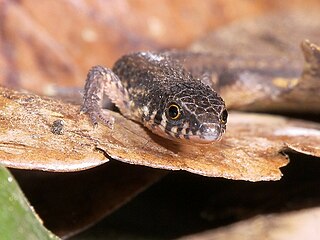
Gymnophthalmidae is a family of lizards with at least 250 species, sometimes known commonly as spectacled lizards or microteiids. They are called "spectacled" because of their transparent lower eyelids, which allow them to still see with closed eyes. As in most lizards, except geckos, these eyelids are movable. The Alopoglossidae have been recently moved from this family.
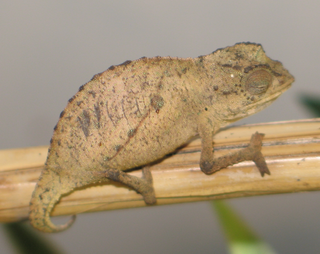
Rhampholeon is a genus of small chameleons, commonly known as pygmy chameleons or African leaf chameleons, found in East Africa and Central Africa. They are found in forests, woodlands, thickets, and savanna, and most species are restricted to highlands. They are brown, grey, or green, and typically seen at low levels in bushes, or on the ground among grasses or leaf litter.
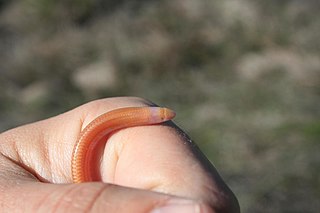
Typhlosaurus is a genus of African lizards, one of a number of genera of limbless lizards in the skink family (Scincidae). This group was recently revised with most species formerly attributed to Typhlosaurus now placed in Acontias. The current definition of Typhlosaurus includes five attenuate body legless lizards from southwestern Africa. This is the sister genus to Acontias, which together form the well supported Afrotropical subfamily Acontinae.

The Amphisbaenidae are a family of amphisbaenians, a group of limbless vertebrates.
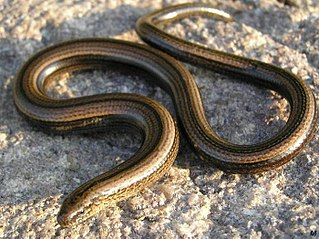
Legless lizard may refer to any of several groups of lizards that have independently lost limbs or reduced them to the point of being of no use in locomotion. It is the common name for the family Pygopodidae. These lizards are often distinguishable from snakes on the basis of one or more of the following characteristics: possessing eyelids, possessing external ear openings, lack of broad belly scales, notched rather than forked tongue, having two more-or-less-equal lungs, and/or having a very long tail. Every stage of reduction of the shoulder girdle —including complete loss— occurs among limbless squamates, but the pelvic girdle is never completely lost regardless of the degree of limb reduction or loss. At least the ilium is retained in limbless lizards and most basal snakes.

Rhineura floridana, known commonly as the Florida worm lizard, graveyard snake, or thunderworm, is a species of amphisbaenian in the family Rhineuridae. The species is the only extant member of the genus Rhineura, and is found primarily in Florida but has been recorded in Lanier County, Georgia. There are no subspecies that are recognized as being valid.
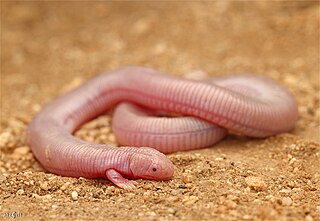
The Mexican mole lizard, also commonly known as the five-toed worm lizard, or simply as Bipes, is a species of amphisbaenian in the family Bipedidae. The species is endemic to the Baja California Peninsula. It is one of three species of amphisbaenians that have legs.

Bedriaga's fringe-fingered lizard is a species of lizard in the family Lacertidae. The species is endemic to Algeria.

The checkerboard worm lizard is a species of amphisbaenian in the family Trogonophidae. The species is monotypic within the genus Trogonophis, and is endemic to North Africa. Its natural habitats are temperate forests, Mediterranean-type shrubby vegetation, temperate grassland, sandy shores, arable land, and pastureland. It is threatened by habitat loss.

Diploglossidae is a family of anguimorph lizards native to the Americas, with most genera being endemic to Hispaniola. Most members of this family are known as galliwasps. They were formerly considered a subfamily of Anguidae, but genetic evidence has shown them to be less closely related to other members of Anguidae than Anniellidae is.
The short worm lizard is a species of reptile in the Trogonophidae family. It is monotypic within the genus Pachycalamus. It is found on the island of Socotra.
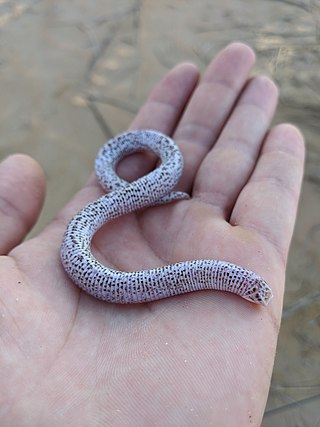
Zarudny's worm lizard is a species of amphisbaenian reptile in the family Trogonophidae. The species is monotypic within the genus Diplometopon. The species is native to the Middle East.
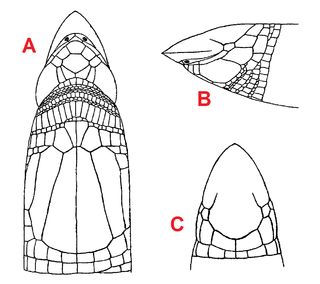
Dalophia is a genus of amphisbaenians in the family Amphisbaenidae, commonly known as worm lizards. Seven species are placed in this genus, all of them endemic to Africa.
The Inirida worm lizard is a species of amphisbaenian in the family Amphisbaenidae. The species is native to Colombia and Venezuela.
Dalophia welwitschii is a species of amphisbaenian in the family Amphisbaenidae. The species is endemic to Angola.

















